Create ASP.NET Core MVC Project
On the Visual Studio, create new ASP.NET Core Web Application project
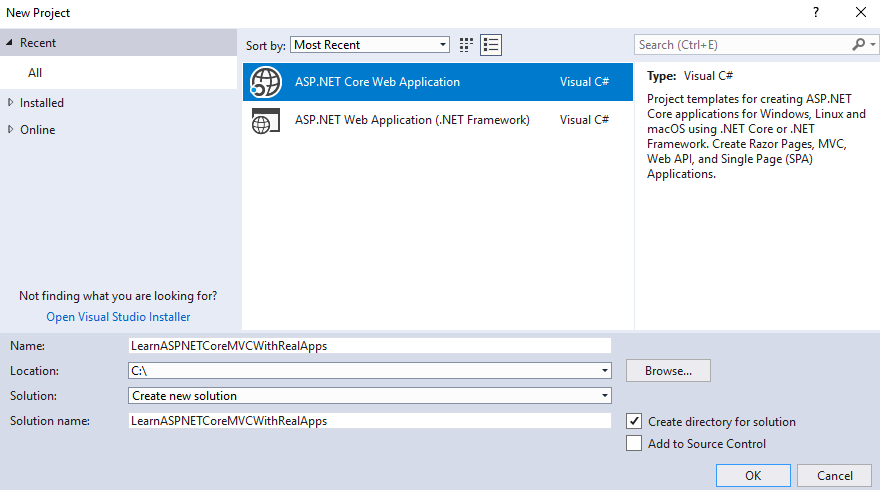
Select Empty Template
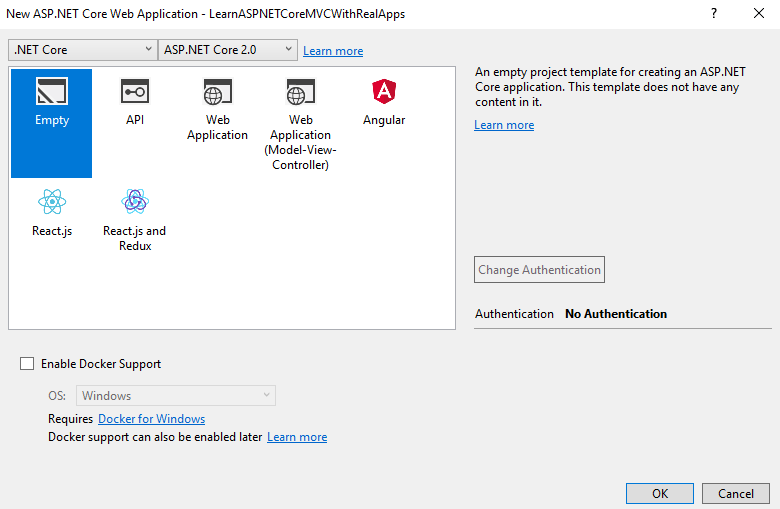
Click Ok button to Finish
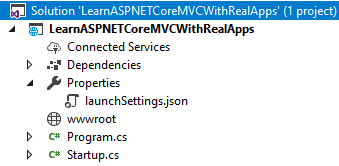
Add Configurations
Open Startup.cs file and add new configurations as below:
using Microsoft.AspNetCore.Authentication.Cookies;
using Microsoft.AspNetCore.Builder;
using Microsoft.AspNetCore.Hosting;
using Microsoft.Extensions.DependencyInjection;
namespace LearnASPNETCoreMVCWithRealApps
{
public class Startup
{
public void ConfigureServices(IServiceCollection services)
{
services.AddAuthentication(CookieAuthenticationDefaults.AuthenticationScheme)
.AddCookie(options =>
{
options.LoginPath = "/Account/Index";
options.LogoutPath = "/Account/SignOut";
options.AccessDeniedPath = "/Account/AccessDenied";
});
services.AddMvc();
}
public void Configure(IApplicationBuilder app, IHostingEnvironment env)
{
if (env.IsDevelopment())
{
app.UseDeveloperExceptionPage();
}
app.UseStaticFiles();
app.UseMvc();
app.UseAuthentication();
app.UseMvc(routes =>
{
routes.MapRoute(
name: "default",
template: "{controller=Account}/{action=Index}/{id?}");
});
}
}
}
Entities Class
Create new folder named Models. In this folder, create new class named Account.cs as below:
Account Entity
Create new class named Account.cs as below:
namespace LearnASPNETCoreMVCWithRealApps.Models
{
public class Account
{
public string Username { get; set; }
public string Password { get; set; }
public string[] Roles { get; set; }
}
}
Models Class
In Models folder, create new class named AccountModel.cs as below:
AccountModel.cs
using System.Collections.Generic;
using System.Linq;
namespace LearnASPNETCoreMVCWithRealApps.Models
{
public class AccountModel
{
private List<Account> accounts;
public AccountModel()
{
accounts = new List<Account>();
accounts.Add(new Account()
{
Username = "acc1",
Password = "123",
Roles = new string[] { "superadmin", "admin", "employee" }
});
accounts.Add(new Account()
{
Username = "acc2",
Password = "123",
Roles = new string[] { "admin", "employee" }
});
accounts.Add(new Account()
{
Username = "acc3",
Password = "123",
Roles = new string[] { "employee" }
});
}
public Account find(string username)
{
return accounts.SingleOrDefault(a => a.Username.Equals(username));
}
public Account login(string username, string password)
{
return accounts.SingleOrDefault(a => a.Username.Equals(username) && a.Password.Equals(password));
}
}
}
Security Manager
Create Security folder in project. This folder contains class need for security in ASP.NET Core MVC as below:
SecurityManager Class
using Microsoft.AspNetCore.Authentication;
using Microsoft.AspNetCore.Authentication.Cookies;
using Microsoft.AspNetCore.Http;
using LearnASPNETCoreMVCWithRealApps.Models;
using System.Collections.Generic;
using System.Security.Claims;
namespace LearnASPNETCoreMVCWithRealApps.Security
{
public class SecurityManager
{
public async void SignIn(HttpContext httpContext, Account account)
{
ClaimsIdentity claimsIdentity = new ClaimsIdentity(getUserClaims(account), CookieAuthenticationDefaults.AuthenticationScheme);
ClaimsPrincipal claimsPrincipal = new ClaimsPrincipal(claimsIdentity);
await httpContext.SignInAsync(CookieAuthenticationDefaults.AuthenticationScheme, claimsPrincipal);
}
public async void SignOut(HttpContext httpContext)
{
await httpContext.SignOutAsync();
}
private IEnumerable<Claim> getUserClaims(Account account)
{
List<Claim> claims = new List<Claim>();
claims.Add(new Claim(ClaimTypes.Name, account.Username));
foreach (var role in account.Roles)
{
claims.Add(new Claim(ClaimTypes.Role, role));
}
return claims;
}
}
}
Create Controllers
Create new folder named Controllers. In this folder, create new controllers as below:
Demo Controller
Create new controller named DemoController.cs as below:
using Microsoft.AspNetCore.Authorization;
using Microsoft.AspNetCore.Mvc;
namespace LearnASPNETCoreMVCWithRealApps.Controllers
{
public class DemoController : Controller
{
[AllowAnonymous]
public IActionResult Index()
{
return View();
}
[Authorize(Roles = "superadmin")]
public IActionResult Work1()
{
return View("Work1");
}
[Authorize(Roles = "superadmin,admin")]
public IActionResult Work2()
{
return View("Work2");
}
[Authorize(Roles = "superadmin,admin,employee")]
public IActionResult Work3()
{
return View("Work3");
}
}
}
Account Controller
Create new controller named AccountController.cs as below:
using Microsoft.AspNetCore.Mvc;
using LearnASPNETCoreMVCWithRealApps.Models;
using LearnASPNETCoreMVCWithRealApps.Security;
namespace LearnASPNETCoreMVCWithRealApps.Controllers
{
public class AccountController : Controller
{
private SecurityManager securityManager = new SecurityManager();
public IActionResult Index()
{
return View();
}
[HttpPost]
public IActionResult Login(string username, string password)
{
AccountModel accountModel = new AccountModel();
if (string.IsNullOrEmpty(username) || string.IsNullOrEmpty(password) || accountModel.login(username, password) == null)
{
ViewBag.error = "Invalid";
return View("Index");
}
else
{
securityManager.SignIn(this.HttpContext, accountModel.find(username));
return RedirectToAction("Welcome");
}
}
public IActionResult Welcome()
{
return View("Welcome");
}
public IActionResult AccessDenied()
{
return View("AccessDenied");
}
public IActionResult SignOut()
{
securityManager.SignOut(this.HttpContext);
return RedirectToAction("Index");
}
}
}
Create View
Create new folder named Views. In this folder, create new views as below:
Account Views
Create new folder named Account folder. In this folder, create new views as below:
Index View
Create new view named Index.cshtml as below:
<!DOCTYPE html>
<html>
<head>
<meta name="viewport" content="width=device-width" />
<title>Login</title>
</head>
<body>
<h3>Login Page</h3>
@ViewBag.error
<form method="post" asp-controller="account" asp-action="login">
<table>
<tr>
<td>Username</td>
<td>
<input type="text" name="username" />
</td>
</tr>
<tr>
<td>Password</td>
<td>
<input type="password" name="password" />
</td>
</tr>
<tr>
<td> </td>
<td>
<input type="submit" value="Login" />
</td>
</tr>
</table>
</form>
</body>
</html>
Welcome View
Create new view named Welcome.cshtml as below:
@using System.Security.Claims;
@{
var userId = User.FindFirst(ClaimTypes.Name);
}
<!DOCTYPE html>
<html>
<head>
<meta name="viewport" content="width=device-width" />
<title>Welcome</title>
</head>
<body>
<h3>Welcome Page</h3>
Welcome @userId.Value
<br />
<a asp-controller="account" asp-action="SignOut">Logout</a>
</body>
</html>
Access Denied View
Create new view named AccessDenied.cshtml as below:
<!DOCTYPE html>
<html>
<head>
<meta name="viewport" content="width=device-width" />
<title>Access Denied</title>
</head>
<body>
<h3>Access Denied Page</h3>
</body>
</html>
Demo Views
Createw new folder named Demo. In this folder, create new views as below:
Index View
Create new view named Index.cshtml as below:
<!DOCTYPE html>
<html>
<head>
<meta name="viewport" content="width=device-width" />
<title>Index</title>
</head>
<body>
<h3>Index Page</h3>
</body>
</html>
Work1 View
Create new view named Work1.cshtml as below:
<!DOCTYPE html>
<html>
<head>
<meta name="viewport" content="width=device-width" />
<title>Work 1</title>
</head>
<body>
<h3>Work 1 Page</h3>
</body>
</html>
Work2 View
Create new view named Work2.cshtml as below:
<!DOCTYPE html>
<html>
<head>
<meta name="viewport" content="width=device-width" />
<title>Work 2</title>
</head>
<body>
<h3>Work 2 Page</h3>
</body>
</html>
Work3 View
Create new view named Work3.cshtml as below:
<!DOCTYPE html>
<html>
<head>
<meta name="viewport" content="width=device-width" />
<title>Work 3</title>
</head>
<body>
<h3>Work 3 Page</h3>
</body>
</html>
Structure of ASP.NET MVC Core Project
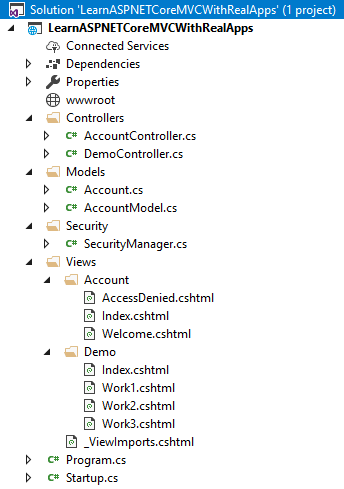
Run Application
-
Access Index action in Account controller with following url: http://localhost:49328/Account/Index
Output
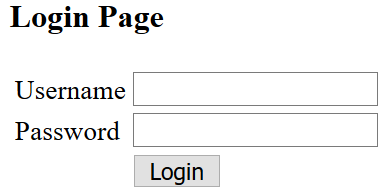
-
Test access Index action in Demo controller without account with url: http://localhost:49328/Demo/Index
Output

-
Test access Work1 action in Demo controller without account with url: http://localhost:49328/Demo/Work1
Output

-
Test access Work2 action in Demo controller without account with url: http://localhost:49328/Demo/Work2
Output

-
Test access Work3 action in Demo controller without account with url: http://localhost:49328/Demo/Work3
Output

-
Test login with invalid account: username is abc and password is 456
Output
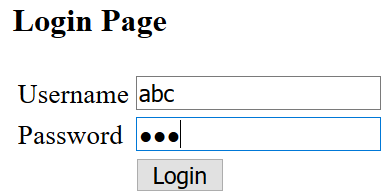
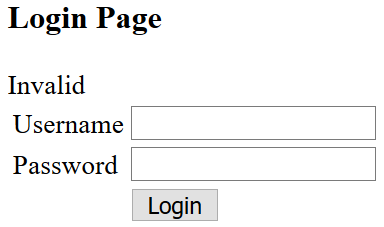
-
Test login with valid account: username is acc2 and password is 123. This account have roles: admin and employee
Output
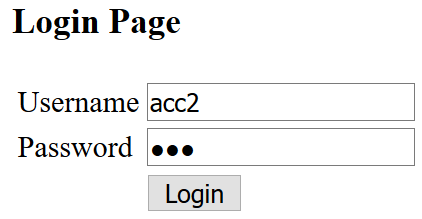
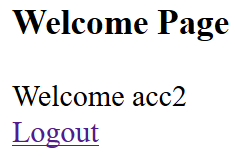
-
Use acc2 has logged access Work1 action in Demo controller with url: http://localhost:49328/Demo/Work1
Output

-
Use acc2 has logged access Work2 action in Demo controller with url: http://localhost:49328/Demo/Work2
Output

-
Use acc2 has logged access Work3 action in Demo controller with url: http://localhost:49328/Demo/Work3
Output



